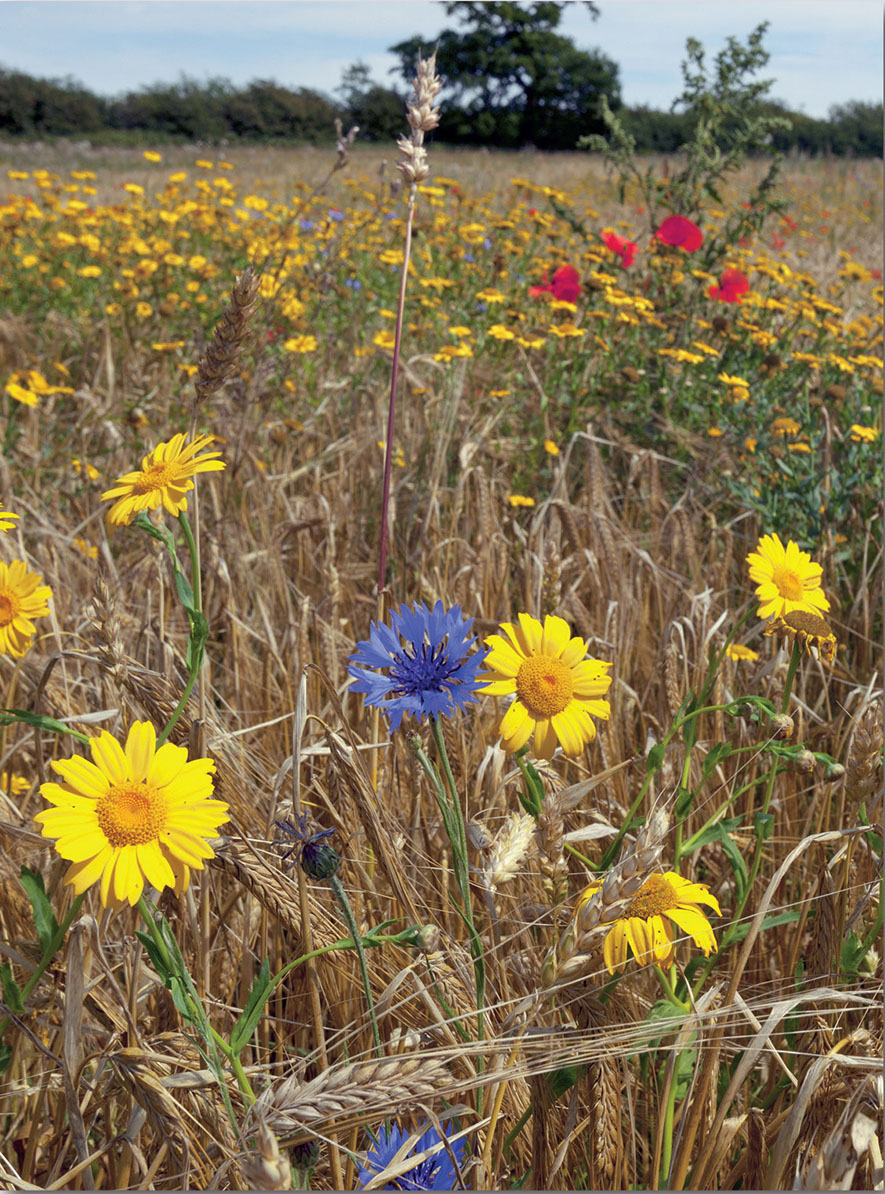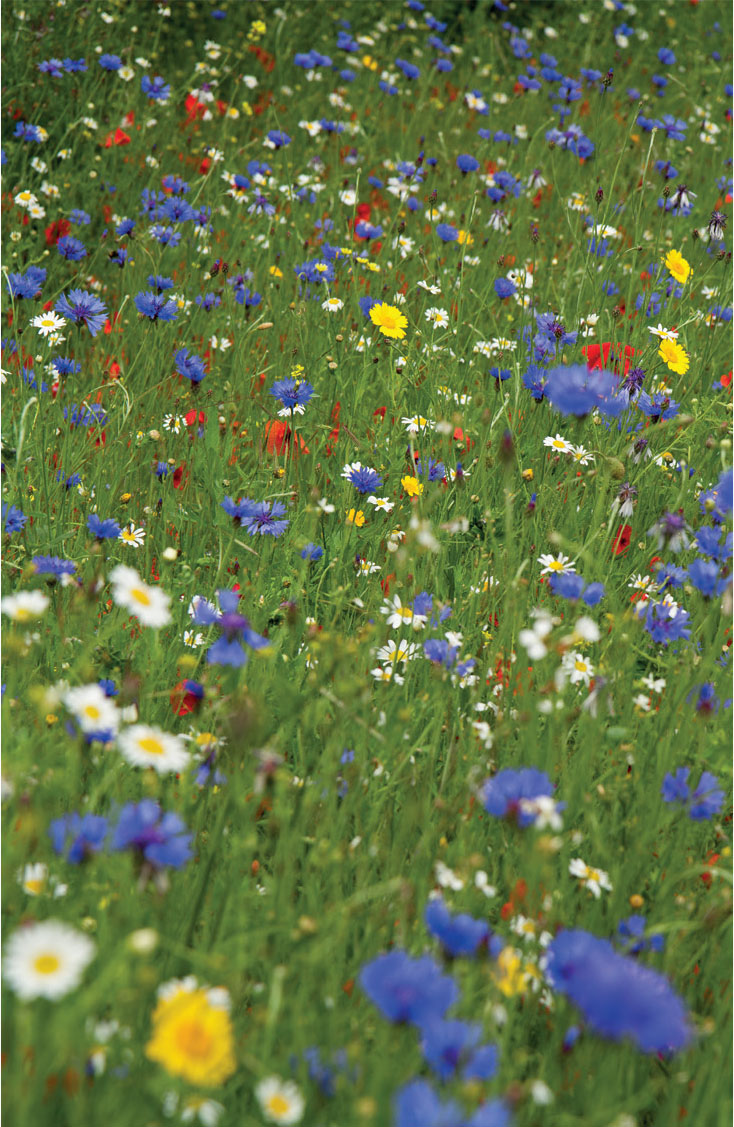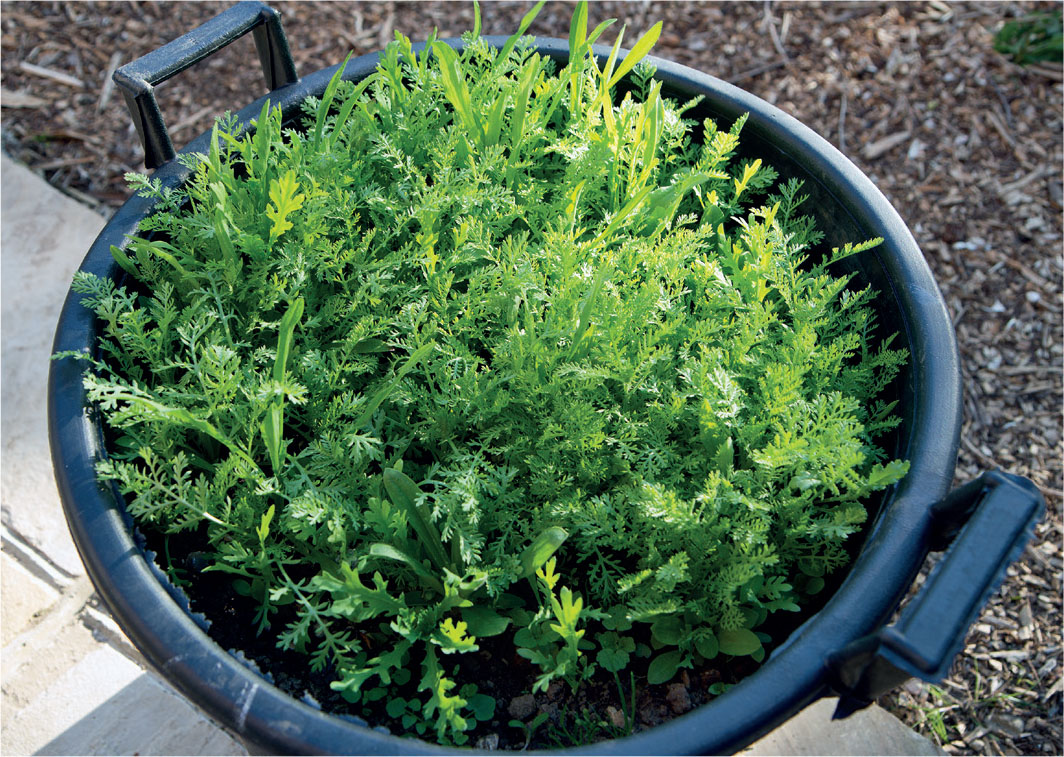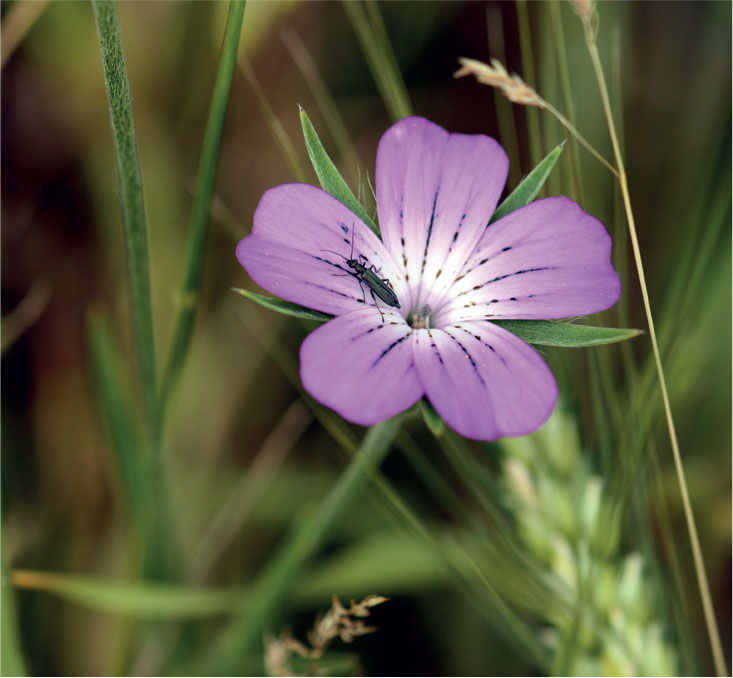
Making a Cornfield Home
A century ago, our cornfields were a visual feast because of all the beautiful ‘weeds’ among the corn, a treat for pollinating insects and rich pickings for farmland birds.
Then, just as in our meadows, things changed. New technology meant that weed seeds could be separated and destroyed from the cereal seeds before they were sown, and chemical herbicides knocked out most weeds that were left in the soil. All those wildflowers that once shone so brightly but had tainted the harvest could now be eradicated.
It’s hard to imagine every farm ever having a reason to return to weed-filled crops, no matter how attractive or good for wildlife they are, so it is in our gardens where we have one of the best opportunities to revisit some of these lost glories.
KEY SPECIES
—The cornfield flowers themselves
—Finches
—Hoverflies
—Beetles
—Bees
The inspiration

These days you can find a few fields full of poppies, one of the few species that can be resistant to herbicides, but rarely exquisite scenes like this.
Most cornfield flowers are annuals. They germinate, grow, flower, set seed and die within a single season, their copious seeds tumbling back into the earth they came from.
Few perennial plants can tolerate the regular upheaval of land that gets ploughed each year.
Bees and other pollinating insects find food in the wealth of flowers. Even Grasshoppers can find a suitable home here.
Several cornfield flowers that were once prolific have now pretty much been eradicated from the British countryside, such as the Corncockle and the blue Cornflower (left).
At the end of summer, when the corn is harvested and the soil ploughed, many of the cornfield flower seeds are buried where they want to be, in the soil.
Those seeds left lying on the soil give seed-eating finches and buntings a field day, but enough weed seed is left for a new generation of flowers to bloom the following year.
How to make your cornfield garden: step by step
In simple terms, what you are going to do is scatter a load of flower seeds on a bare, prepared area of soil, water them, and let nature do the rest, giving you a gorgeous summer display. You are not creating a meadow, no matter what some seed packets will tell you! This is a bed of annual flowers. Check out Making a Wildflower Meadow for more about the differences between the two.
1. Choose a sunny site, as large or small as you like
It could be a large flower border, it could be a tiny corner, the choice is yours, but it should be in a place that gets lots of sunlight. The larger the area, the more wildlife is likely to find and use your cornfield but, as I will show you, you can get beautiful results in just a large plant pot. As a cornfield isn’t a meadow, you don’t need impoverished soil – in fact, some fertility is ideal.
2. Prepare your plot
Get ready for either an autumn (August–early October) or early spring (March–April) sowing. You’re going to be scattering thousands of seeds, so they need ideal conditions for germination. That means a bed of lovely, crumbly, weed-free soil. Some people advocate using a glyphosphate weedkiller to prepare the seedbed, which kills weeds on touch but doesn’t have a long term effect in the soil. I stick to organic methods, which are rather more labour-intensive, in which I dig or rotavate the soil and then hoe off any weeds that emerge. It’s a bit of a bind, but a vital step. Once free of weeds, rake until the soil on the surface is a fine tilth.
3. Measure your area and buy your seed
You will need about 2 grams of seed per square metre. Look for those called ‘cornfield annual mix’ or something similar. One seed packet is usually way too much for a pot, but you’ll need to buy larger quantities for a large border.

If sowing a large area, divide your seed up into equal batches and likewise with your plot – you’ll get a more even spread of seed.

Note how there are no poppies flowering in this mix I sowed in spring; the photo might have been filled with red had I sown the same mix in autumn.
4. Broadcast the seed
Sow your seed evenly. To help, mix the seed with silver sand (about 100 parts sand to one part seed is fine). When sowing a large area, I like to divide my plot up into equal sections and then I split my sand-seed mix into the same number of batches. Just take handfuls of the sand-seed mixture and swish them side to side across the sowing area: it’s very satisfying! You don’t need to rake the seed in; just walk across the surface to make sure it is in contact with the soil. Then water with a fine rose, and you will need to keep it watered in any dry periods.
5. Sit back and enjoy the summer spectacle
The plants should germinate quickly but it seems to take an age for them to spread a blanket of green across the plot. Then growth accelerates into summer and before you know it flowers are bursting out everywhere! Poppies tend to dominate from autumn sowings; Corn Chamomile, Corn Marigold and Corncockle come to the fore if you sow in spring. Seeds sown in autumn tend to flower from about June; those sown in spring flower after about 12 weeks. The main show should last about four weeks, but a few flowers may keep going until the frosts.

Cornflowers are dominating the mix here, which is no bad thing as they are perhaps the best of the mix for pollinating insects, and intensely beautiful too.
6. In late August or September, scythe the crop down to about 5cm
Either leave the cuttings on the soil for a few days so that the new seed drops onto the soil, or lay it on a tarpaulin so you can collect the seeds that fall onto it. Then gather up and compost.
7. If you want a repeat show again next year...
It is possible to just lightly cultivate the soil in autumn, and all the seed that has dropped from this year’s crop will provide you with the basis of next year’s display. However, this often isn’t as successful for two reasons. Firstly, unwanted ‘weeds’ may have crept in among your crop this year. Annual Meadow Grass, Nettle, Sow-thistles, whatever is abundant nearby may start to invade. Secondly, whichever of your cornfield flowers did well in Year 1 will have seeded well and so is likely to do even better next year, increasingly at the expense of those flowers that weren’t so abundant. So few poppies one year will probably mean even fewer the next. If you want to be sure of a good performance next year, my best advice is that either to do a very thorough weed in autumn and replenish the seeds with extra of whatever flowers performed poorly, or start from fresh and go back to Step 1.



Here’s a standard cornfield mix I sowed in a large pot on 6 April (top). By 17 May, it was a fuzz of green seedlings (centre); by 6 July it was in full flower (bottom).
The key flowers of the cornfield
 Common (or Field) Poppy The signature plant of the cornfield for many people; just remember to sow in autumn for best results. A great plant for bees.
Common (or Field) Poppy The signature plant of the cornfield for many people; just remember to sow in autumn for best results. A great plant for bees.
 Corn Marigold The large, daisy-like flowers are a vibrant yellow, and are great for hoverflies and solitary bees.
Corn Marigold The large, daisy-like flowers are a vibrant yellow, and are great for hoverflies and solitary bees.
 Corn Chamomile Not a great plant for pollinators, but a welcome dash of daisy colours and plentiful seed.
Corn Chamomile Not a great plant for pollinators, but a welcome dash of daisy colours and plentiful seed.
 Corncockle The pink-mauve flowers with a white centre I find work best for pollinating beetles. The seeds are large.
Corncockle The pink-mauve flowers with a white centre I find work best for pollinating beetles. The seeds are large.
 Cornflower The intensity of the blue is hard to match in the garden, and is probably the best of the bunch for bees and bumblebees.
Cornflower The intensity of the blue is hard to match in the garden, and is probably the best of the bunch for bees and bumblebees.

A single Corn Marigold pokes out from a sea of Corn Chamomile. In my garden, Field Voles and Grass Snakes hunt under the dense cover of the stems and flowers.
To recreate the authentic cornfield effect, why not add some cereal seeds, such as wheat, barley and oats, which will then produce heads full of fresh seed for sparrows and finches. When sowing cereal seed, it is best to sow them first, rake them into the seedbed so they are covered, and then scatter the wildflower seed onto the surface.
There are several other flowers you might like to add to the mix which would also have turned up in cornfields in times gone by. Those with a long history in the UK include Field Pansy, Linseed (Common Flax), Scented Mayweed and Night-flowering Catchfly. White Campion is sometimes offered, but can be a bit robust. Some mixes even come with very rare plants such as Thorow-wax and Corn Buttercup.
Adding extra spice
It is thought that most cornfield annuals are archaeophytes, plants that were brought in by early settlers with cereal seed, some possibly as long ago as the Iron Age. It means that you needn’t feel too guilty about being a ‘modern settler’ and adding a little bit of something more fanciful to the mix.

Corncockle came to Britain in the Iron Age, but became extinct as an arable weed in the 20th century. Gardeners are helping it make a comeback.
‘Exotic’ annuals are just as easy to grow as the conventional cornfield annuals, and some fantastic seed mixes have been developed to offer a long flowering season and different colour combinations. The seed merchants have turned to northern Africa for the vibrant Red Flax and Fairy Toadflax and to North America for Californian Poppy and the Midwestern Tickseed. Bee-magnets such as Scorpion Weed and Poached-egg Plant are definitely worth including, and your palette can include Opium Poppy, Cosmos, Larkspur and Bishop’s Flower.
Cornfield annuals as the ‘first act’ for perennial meadows
You can, if you want, mix in cornfield annual seeds when you sow a perennial wildflower meadow (see here). Just mix the two types of seed together at the start. You will get a flush of colourful annuals in the first year that then quickly peters out as the perennials take over in subsequent years. Remember though to start with the infertile soil that the perennial meadows will need.

The exquisite Cornflower is desperately rare in the wild, but easy to grow in gardens.